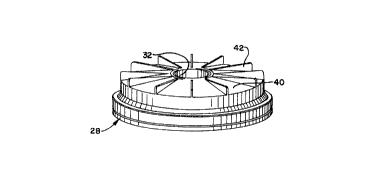Une partie des informations de ce site Web a été fournie par des sources externes. Le gouvernement du Canada n'assume aucune responsabilité concernant la précision, l'actualité ou la fiabilité des informations fournies par les sources externes. Les utilisateurs qui désirent employer cette information devraient consulter directement la source des informations. Le contenu fourni par les sources externes n'est pas assujetti aux exigences sur les langues officielles, la protection des renseignements personnels et l'accessibilité.
L'apparition de différences dans le texte et l'image des Revendications et de l'Abrégé dépend du moment auquel le document est publié. Les textes des Revendications et de l'Abrégé sont affichés :
| (12) Brevet: | (11) CA 2047878 |
|---|---|
| (54) Titre français: | APPAREIL DE FILTRATION DE L'EAU |
| (54) Titre anglais: | WATER-FILTRATION APPARATUS |
| Statut: | Réputé périmé |
| (51) Classification internationale des brevets (CIB): |
|
|---|---|
| (72) Inventeurs : |
|
| (73) Titulaires : |
|
| (71) Demandeurs : | |
| (74) Agent: | JOHNSON, DOUGLAS S. Q.C. |
| (74) Co-agent: | |
| (45) Délivré: | 1997-11-25 |
| (22) Date de dépôt: | 1991-07-25 |
| (41) Mise à la disponibilité du public: | 1992-04-13 |
| Requête d'examen: | 1993-07-15 |
| Licence disponible: | S.O. |
| (25) Langue des documents déposés: | Anglais |
| Traité de coopération en matière de brevets (PCT): | Non |
|---|
| (30) Données de priorité de la demande: | ||||||
|---|---|---|---|---|---|---|
|
Appareil de filtration pour réduire les contaminants dans l'eau utilisée à des fins domestiques et autres semblables. L'appareil comprend un récipient d'eau avec un réservoir récepteur monté dans le récipient. Le réservoir loge un filtre et un premier passage est formé au sommet du réservoir pour le raccordement du réservoir au filtre. Un deuxième passage permet l'écoulement de l'eau du premier passage pour qu'elle entre en contact avec un écran espacé du premier passage. Une première chambre définie entre le premier passage et l'écran est raccordée par un troisième passage à une deuxième chambre située de l'autre côté de l'écran. Le filtre comprend aussi une paroi de fond définissant des ouvertures qui communiquent avec la deuxième chambre. Le matériau filtrant se trouve entre la première et la deuxième chambre de sorte que l'eau introduite dans le réservoir récepteur descend par le premier passage, passe latéralement par le deuxième passage à la première chambre, remonte en traversant la première chambre et passe ensuite latéralement par le troisième passage pour se rendre à la deuxième chambre. L'eau descend enfin de la deuxième chambre et sort par les ouvertures de la paroi de fond pour entrer dans le récipient d'eau.
A filtration apparatus for reducing contaminants in
water used for household purposes and the like. The apparatus
includes a water container with a receiving reservoir
mounted in the container. The reservoir houses a filter and
a first passage is formed at the top end of the reservoir
for connecting the reservoir with the filter. A second
passage permits the flow of water from the first passage
into contact with a barrier wall spaced away from the first
passage. A first chamber defined between the first passage
and the barrier wall is connected by means of a third
passage to a second chamber located on the other side of the
barrier wall. The filter also includes a bottom wall
defining openings communicating with the second chamber.
Filtering material is located within the first and second
chambers so that water introduced into the receiving
reservoir passes downwardly through the first passage,
transversely through the second passage into the first
chamber, upwardly through the first chamber, and then
transversely through the third passage to the second
chamber. The water then travels downwardly through the
second chamber and outwardly through the bottom wall
openings for entering into the water container.
Note : Les revendications sont présentées dans la langue officielle dans laquelle elles ont été soumises.
Note : Les descriptions sont présentées dans la langue officielle dans laquelle elles ont été soumises.

Pour une meilleure compréhension de l'état de la demande ou brevet qui figure sur cette page, la rubrique Mise en garde , et les descriptions de Brevet , États administratifs , Taxes périodiques et Historique des paiements devraient être consultées.
| Titre | Date |
|---|---|
| Date de délivrance prévu | 1997-11-25 |
| (22) Dépôt | 1991-07-25 |
| (41) Mise à la disponibilité du public | 1992-04-13 |
| Requête d'examen | 1993-07-15 |
| (45) Délivré | 1997-11-25 |
| Réputé périmé | 1999-07-26 |
Il n'y a pas d'historique d'abandonnement
| Type de taxes | Anniversaire | Échéance | Montant payé | Date payée |
|---|---|---|---|---|
| Le dépôt d'une demande de brevet | 0,00 $ | 1991-07-25 | ||
| Enregistrement de documents | 0,00 $ | 1993-05-11 | ||
| Taxe de maintien en état - Demande - nouvelle loi | 2 | 1993-07-26 | 100,00 $ | 1993-06-08 |
| Taxe de maintien en état - Demande - nouvelle loi | 3 | 1994-07-25 | 100,00 $ | 1994-06-30 |
| Taxe de maintien en état - Demande - nouvelle loi | 4 | 1995-07-25 | 100,00 $ | 1995-07-05 |
| Taxe de maintien en état - Demande - nouvelle loi | 5 | 1996-07-25 | 150,00 $ | 1996-07-18 |
| Taxe finale | 300,00 $ | 1997-07-18 | ||
| Taxe de maintien en état - Demande - nouvelle loi | 6 | 1997-07-25 | 150,00 $ | 1997-07-25 |
Les titulaires actuels et antérieures au dossier sont affichés en ordre alphabétique.
| Titulaires actuels au dossier |
|---|
| WILTON INDUSTRIES, INC. |
| Titulaires antérieures au dossier |
|---|
| DEARE, DAVID W. |